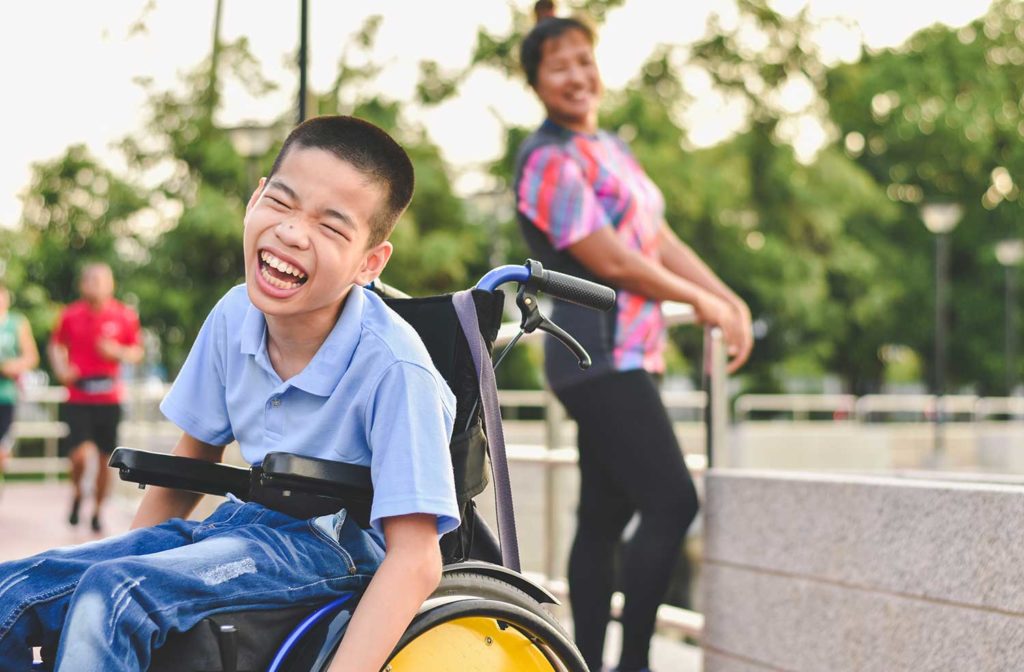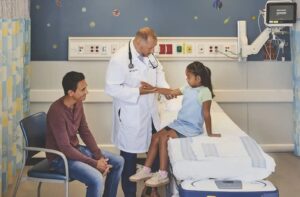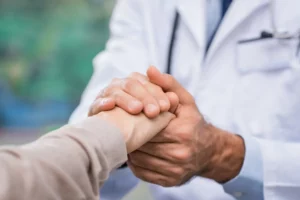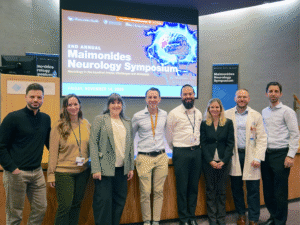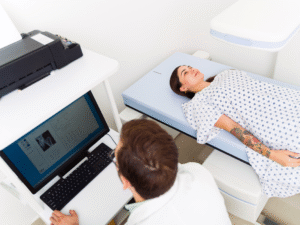Summary
Muscular dystrophy, inherited neuropathies, ALS are rare – but together potentially affect thousands of people in Brooklyn. In the US, patients often have to travel far to get care because there are no specialists nearby.
Thanks to Maimonides (and our partner SUNY Downstate), adults and children can now get ongoing individualized care from muscular dystrophy experts close to home. Join us as Dr. Simona Treidler and Dr. Nuri Jacoby discuss how being the new Muscular Dystrophy Association clinic can help support Brooklyn families.
Listen on Spotify Listen on Apple Podcasts Listen on Google Podcasts
Transcript
Caitlin Whyte (Host): Treating muscular dystrophy is complex and the condition takes many forms. Muscular dystrophy, inherited neuropathies, ALS. They’re rare, but together, potentially affect thousands of people in Brooklyn. In the US, patients often have to travel far to get care because there are no specialists nearby. Thanks to Maimonides and our partner, SUNY downstate, adults and children can now get ongoing individualized care from muscular dystrophy experts close to home. It can be a particular challenge for families to find neuromuscular experts with expertise in treating children with MD and clinics that provide continuity of care as children transition into adulthood.
Maimonides offers this expertise. Joining us to talk about these resources are Dr. Nuri Jacoby, an Assistant Professor and Neurology Director and Dr. Simona Treidler, a Neurologist and Neuromuscular Specialist. This is Maimo Med Talk. I’m your host, Caitlin Whyte. So, Dr. Jacoby, what is muscular dystrophy? Who does it affect and how?
Nuri Jacoby, MD (Guest): So, muscular dystrophies are a group of more than 30 genetic diseases. They’re characterized by progressively worsening weakness and loss of muscle, and they’re due to genetic mutations. So, they’re inherited from a parent or a grandparent. Depending on the disease, it can affect different muscle groups, so it can affect the arms, you know, not allowing a person to carry things. It can affect the legs, so it can affect walking and the facial muscles, so, it can affect speaking. It can affect difficulty chewing or swallowing. It affects people of all different ages. So, some of them occur right after birth. A lot of them occur in childhood. And some of them occur when a person is 60 or 70 years old. You know, it really affects people.
So, as I mentioned, you know, the muscles affect so many parts of the body, so it can affect someone’s mobility. It can affect the speech and swallow, it can really cause someone to not be able to eat very well. And it’s also important to remember that the heart and diaphragm are also muscles. So, it can really affect the heart causing what’s called a cardiomyopathy and the diaphragm can cause shortness of breath or difficulty breathing. They’re overall a pretty rare group of disorders, but if you put all them together, there’s a good amount of people who suffer from them. Probably the most common is Duchenne’s muscular dystrophy, which really affects boys in childhood, but there’s other types such as myotonic muscular dystrophy, limb girdle muscular dystrophy, and facioscapulohumeral muscular dystrophy.
Even though the clinic is an MDA clinic, it’s important to note that we don’t only see muscular dystrophies in the clinic. So, we see all types of genetic neuromuscular disorders and some non-genetic neuromuscular disorders like ALS or Lou Gehrig’s disease and myasthenia gravis as well.
Host: Now, what is an MDA clinic Dr. Jacoby? And how is it different than seeing just your family doctor or a neurologist?
Dr. Jacoby: Yeah, that’s a good question. So, an MDA clinic is a clinic sponsored by the Muscular Dystrophy Association. And in order to be sponsored by the MDA, you really need to meet certain benchmarks with regards to quality of care and with regards to seeing a certain amount of patients and you have to reapply every year to get grants. The MDA, the Muscular Dystrophy Association began in 1950, really to raise awareness and to raise funding for research of muscular dystrophies. They sponsor about 150 care centers or MDA clinics in the country. Coming to an MDA clinic is very different than seeing a local neurologist or a primary care doctor. And that’s for a few reasons. One, you’re seeing a neuromuscular specialist. So, you’re seeing someone like Dr. Treidler or myself, where we did, you know, extra training in neuromuscular diseases and really have an expertise in these disorders that many neurologists do not have. The second, is that the clinic is multidisciplinary. So, there’s a whole team at every clinic to really help provide optimal care to patients. You know, as I mentioned, since muscles effect so many parts of the body, we really need to make sure that we have a comprehensive approach to treating patients. So, as part of an MDA clinic, in addition to neuromuscular specialists, there are often rehab specialists, physical and occupational therapists, social workers, respiratory therapists, to help with breathing and an orthotist who can help embraces and splints.
We also work closely with heart and lung doctors and orthopedic surgeons. And some patients may have what’s called scoliosis or a curving of the spine. So, during a clinic session, you’re not just seeing one person, but you’re really seeing a whole team.
Host: Dr. Treidler, we know children are affected by muscular dystrophy as well. What are some of the conditions affecting children and some of the symptoms their parents should look out for as well as innovations and treatments that you’re excited about?
Simona Treidler, MD (Guest): Well, thank you very much. The most common neuromuscular conditions affecting children are Duchenne’s muscular dystrophy and a milder phenotype called Becker muscular dystrophy, myotonic dystrophy, facioscapulohumeral muscular dystrophy and limb girdle muscular dystrophy, which are a group of inherited conditions affecting the muscles around the hips and shoulders.
Other neuromuscular disorders affecting children are spinal muscular atrophy called SMA shortly, congenital myopathies, congenital myasthenic syndrome, metabolic and mitochondrial myopathies, myasthenia gravis and inherited or acquired peripheral neuropathy. Some of the symptoms that parents should look for are a baby who has a low muscle tone. You lift him up and he’s floppy. Looking at the motor developmental of babies, such as holding the head up, sitting and standing and noticing all a bit of delay especially if you have an older child that you can compare with. When they grow up a little bit, the children can show large gaps. They have difficulty getting up from the ground or from a low chair, they have problems climbing stairs.
They tiptoe walking. They trip, they fall frequently. They have difficulty jumping, hopping, and running. They show inability to keep up with a peer during physical activities. They have trouble lifting up objects. They show fatigability and shortness of breath. Some of them, they may have behavioral learning problems and speech delay.
In regards to your question about treatment, this is a very exciting time in neuromuscular medicine due to approval of multiple treatments for children with neuromuscular disorders. For example in Duchenne’s muscular dystrophy, FDA has approved five medications in the last five years. And another disease, which has benefited from revolutionary treatments is spinal muscular atrophy.
There are now three therapeutic approaches. That’s a medication called nusinersen that you insert through the lumbar puncture. That’s one time treatment, gene therapy and an oral medication. D enzyme replacement therapies that are available for some of metabolic disorders, such as Pompe and Fabry’s disease.
What is unique about our clinic at Maimonides it is that we can provide the various most transition from being a child to becoming an adult because we are trained in taking care of neuromuscular disorders in children and adults.
Host: And Dr. Treidler, that leads me into my next question, which is the same, but for adults, what developments are taking place in treating some of the more common types of muscular dystrophy?
Dr. Treidler: The most common muscular dystrophy in adults are a little bit different. Myotonic dystrophy type one and two being the most common and facioscapulohumeral muscular dystrophy, but there are neuromuscular disorders affecting adults, such as amyotrophic lateral sclerosis, ALS, mysathenia gravis, inflammatory and degenerative myopathies including the inclusion body myositis, inherited and acquired neuropathies. Now in regards to treatment for these disorders, unfortunately for muscular dystrophies at this moment in time, there are not treatments available, but there are ongoing clinical trials and they are giving us hope that we’ll be able to treat those patients very, very soon.
We can then offer medical treatment for patients with myasthenia gravis, for example. Most of the time helping them to reach stability and sometimes cure. In 2017, one medication was approved for myasthenia gravis is called eculizumab. There are also medications available for patients with ALS. Two medications that they can benefit right now riluzole and endaravone. Both of them showing positive results in prolonging patients’ life. And there are plenty of ongoing clinical trials in ALS, which we all hope that are going to show good results soon because those patients are in the need for it. Despite a lack of definitive treatments in many neuromuscular disorders affecting adults, we can still help them, alleviating their symptoms, preventing cardiac and respiratory complications as mentioned by Dr. Jacoby and by delaying the muscular weakening, with physical therapy and occupational therapy.
Host: And Dr. Jacoby, are you seeing any other new approaches or research that are especially promising?
Dr. Jacoby: Yeah, I think, I think one of the treatment modalities that I’m really excited about and that Dr. Treidler mentioned is gene therapy. So, we now have gene therapy for spinal muscular atrophy. And so, you know, what we essentially do is we insert a gene into a viral vector and we inject it into the patient. And in spinal muscular atrophy, you know, there’s four different types of SMA or the major types of SMA. And in type one, most patients were not living, you know, much longer than one year or so. And so with gene therapy, we don’t know exactly the life expectancy, but we’re seeing kids who are walking, running and who are doing really well. And so, it’s really transformed the landscape of treatment for spinal muscular atrophy. Something I’m really excited about is that, you know, researchers are working on gene therapy for Duchenne’s muscular dystrophy as well.
Duchenne’s muscular dystrophy is a little bit harder than SMA. And not to get too into the weeds, but you know, one of the major reasons is because the gene for Duchenne’s muscular dystrophy, the DMD gene is just bigger than the gene that’s affected in SMA. And so you can’t fit that whole gene into a viral vector. But there are ways of getting around that. And so what they’re looking into, and there’s three clinical trials looking into this now. They’re putting part of the gene into a viral vector. And by putting part of the gene in and injecting it into a patient, it’s felt that patients may be able to have a much milder phenotype or a much milder symptoms of the disease.
So, instead of not being able to walk, they might have some mild weakness, but it would be a really significant improvement. So, you know, we don’t know exactly when this will be available, but we’re hopeful that it’ll be sometime in the next few years.
Host: Now, why do people say it’s hard to find muscular dystrophy specialists and centers like the Maimonides MDA clinic, Dr. Jacoby? And what are the benefits of having this new center here in Brooklyn?
Dr. Jacoby: Yeah, I think, I think it’s hard because the truth is, is there just aren’t a lot of clinics out there or the clinics that are there, the wait can also just be months long, which is challenging for patients. So, given the population of Brooklyn, you know, the only clinic that’s been, that’s really been available in Brooklyn is at SUNY downstate, which started a little over 10 years ago. We’re going to be a satellite of the SUNY downstate MDA clinic.
So, we’re going to essentially be the second clinic available in Brooklyn. You know, I think that it’s a real opportunity for patients who either in Brooklyn, weren’t able to go to an MDA clinic maybe because their doctors weren’t aware that they existed or, or because they had a disease that just wasn’t diagnosed or because it was hard for them to travel either to Manhattan or the Bronx or Long Island. So, I think giving patients the second clinic in Brooklyn is a real opportunity to really provide comprehensive and specialized care.
Host: Great. Dr. Jacoby, is there anything else you’d like to add to our conversation on muscular dystrophy?
Dr. Jacoby: No, I’m just, I’m really excited and happy that Dr. Treidler and I have had the opportunity to kind of spread the word and talk about our clinic. It’s an exciting time to be a doctor for these patients.
Host: Wonderful and Dr. Treidler, any for you?
Dr. Treidler: Thank you very much again, for giving us the opportunity to speak about our clinic. And again, I’m also very, very excited and I’ve seen the results with the gene therapy in SMA. I’m also grateful that I work in New York State because we have newborn screening. These babies can be diagnosed very, very fast. And then we treat them at, you know, a few weeks of age, which may make a big, big difference in their lives and their parents’ life. Then we really thank you very much for helping us. And we are very excited to take care of our patients.
Host: Well, this sounds like it’s going to really change a lot of lives in the neighborhood. Thank you so much for being with us on the show today. To learn more, please visit maimo.org/neurosciences. This has been Maimo Med Talk. I’m your host, Caitlin Whyte. Stay well .

